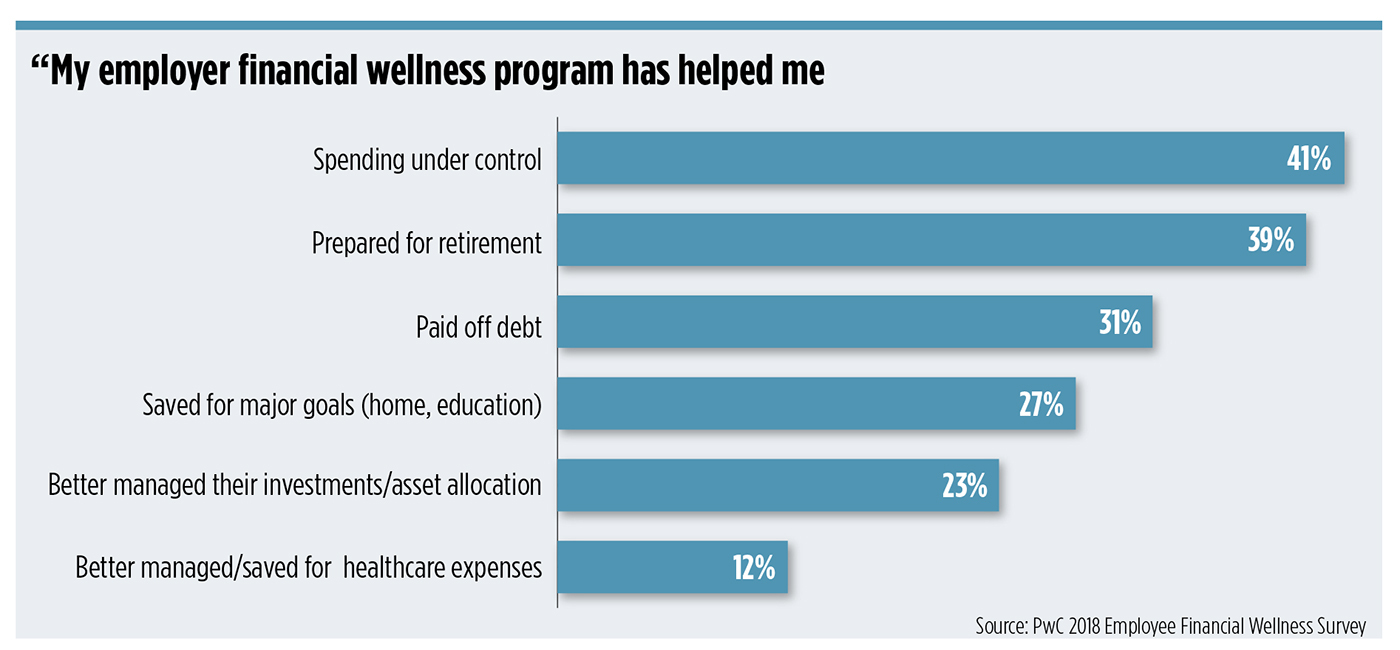As the coronavirus pandemic destabilizes large swaths of the global economy, the consequences of inadequate financial education expose the fault lines of a society unprepared to face the greatest financial challenges since the Great Depression. Now, perhaps more than ever, everyone—workers, managers, legislators and students—need financial literacy skills to navigate uncharted economic uncertainty.
The COVID-19 pandemic confirms that the average American family is woefully unprepared to confront financial stress. Consider just how many Americans don’t have any savings to speak of. Even when the economy was in the longest boom period in history, nearly four in five employees reported being stressed by financial pressures. These pressures led to more absenteeism, higher health care costs for the employer, less engagement and more dissatisfaction with their pay, regardless of the salary they earn.
The consequences of insufficient financial education are well documented. Over half of Americans have less than $1,000 in savings, according to GOBankingRates. The average American household owes $15,654 in credit card debt, NerdWallet revealed in its American Household Credit Card Debt Study.
As for retirement planning, 47% of older households have no defined contribution plans such as an IRA or 401(k). Among those who have such plans, the median defined contribution plan balance of workers ages 55–64 is $92,000, according to The New School’s Schwartz Center for Economic Policy Analysis. The median account balance is just $250,00 for the 10% with the highest earnings.
Inadequate Financial Literacy
Critics have long lamented the lack of financial education. The Standard & Poor’s Ratings Services Global Financial Literacy Survey ranks the U.S. as 14th in the world (tied with Switzerland) when measuring the proportion of adults in the country who are financially literate. At 57%, the literacy rate of the U.S. is only slightly higher than that of Botswana. Canada, with a GDP one-tenth the size of the U.S., has a literacy rate of 68%.
Inadequate financial literacy carries a high cost, and most Americans are aware of only a part of the pain. The National Financial Educators Council found that financial illiteracy cost the average American $1,279 in 2019. That’s more than the $1,200-per-American payment authorized by Congress for the first coronavirus stimulus payment.
That people are generally aware they lack the ability to make sound financial decisions or recognize when sound financial decisions are made for them imposes so much stress on getting through the week or month that many are unable to think meaningfully about the future. That’s one reason too many Americans prioritize consumption over savings, convenience over investment, short-termism over long-term planning. A recent study revealed that one-third of workers would rather take $1,000 now than $3,000 a year from now, according to research by PurePoint Financial.
Even among those with assets, Americans often pay hidden fees when they make investment, debt and retirement decisions without the benefit of financial education. For example, too many Americans lack basic budgeting skills, which leads to paying high levels of credit card interest. Too many Americans that are offered retirement plans fail to take advantage of matching programs. For those that do contribute to such plans, too many Americans borrow against their retirement accounts, triggering penalties when they fail to repay them.
It Starts With the Schools
The problem starts with how few schools incorporate financial education into their curricula. Two-thirds of states have no requirement for high school students to take a course in personal finance, according to the Council for Economic Education. Only five states require a stand-alone personal finance course. It’s no wonder that many workers don’t understand basic financial principles such as how compound interest works or how to create a budget. The results are predictable. People save too little, spend too much, incur too much debt and fail to understand how their behavior mortgages their futures.
In some cases, financial advisors are stepping in to fill the gap. For instance, the Swett Wealth Management Group at UBS in Boston sponsors a financial literacy course for students attending Marblehead High School. Managing Director Jeffrey Swett partnered with EVERFI, a Washington, D.C.–based education technology company, to create a curriculum that combines in-person instruction with online learning. Now that students are studying from home, the financial literacy curriculum is doubly critical for both students and their parents.
The EVERFI Understanding Money learning platform is a web-based program that uses simulations, avatars and gamification to bring complex concepts to life. The program introduces students to nine key principles: savings, banking, payment types, credit scores, financing higher education, renting vs. owning, insurance and taxes, consumer protection, and investments. In a typical year, after students complete the online sections, Swett and his team visit the high school to interact with the students and address questions.
The program offers modules geared for grade school, high school, college and adults. For example, the grade school module introduces the formula SSIG to help young students remember that there are only four things you can do with money: save it, spend it, invest it and give it away.

Indications suggest that with school closures and families quarantined at home, there is an uptake in the module activity at all levels. That’s certainly true in the Swett household, which includes three teens, in the seventh, 10th and 12th grades. “In our own house, we are encouraging them to go through all the modules.” In addition, the ripple effect of these courses is evident as students share the content with parents and siblings, an outcome the program encourages.
“Despite the importance of personal finance, it is a topic that has notoriously been under-emphasized in school curricula throughout the country,” Swett observes. The goal is to improve the financial literacy of young people and, as they get older, to help them become financially independent. The program tracks individual student progress and knowledge gain. “In the long term, it is our hope that these efforts translate into smarter financial decisions around spending, saving, managing and investing down the road,” he says.
It stands to reason that financial advisors should be on the forefront of advocating for financial literacy. But Swett’s example of providing financial education to young people for its own sake is an outlier. Most advisors offer seminars and workshops that often provide valuable education, but the programs are well understood to be motivated more by asset gathering needs than free education.
“Financial advisors should be the go-to person for financial education—they’re well-educated, this is their happy playground,” says Inci Kaya, lead analyst for health and financial wellness at Aite Group. “It is surprising that employers don’t necessarily think about the financial advisors when it comes to implementing financial education programs.”
Why Financial Literacy Programs Underperform
One reason the average financial literacy program underperforms is that there’s no well-understood definition. It’s telling that the Consumer Financial Protection Bureau declines to provide one. The President’s Advisory Council on Financial Literacy defines personal financial literacy as “the ability to use knowledge and skills to manage financial resources effectively for a lifetime of financial well-being.”
Employees don’t want to be sold financial services in the guise of financial education. Many companies have made the mistake of outsourcing their financial literacy programs to their retirement plan administrators or other vendors. Nothing will invalidate a financial literacy program more than the suspicion among employees that they are being used as a sales channel for insurance, annuities, mutual funds, or other products and services. Employers must act as a fiduciary in this regard and ensure that any financial guidance they offer is in the best interests of the employees. Typically, the most effective financial wellness programs are delivered by firms whose sole focus is financial wellness. Ideally, the plans should be delivered by financial advisors and coaches who hold a CFP or similar certification.
The effectiveness of financial literacy programs is notoriously difficult to measure. Most plan sponsors attempt to measure engagement, satisfaction and financial improvement. It’s often taken for granted that better informed people make better financial decisions. That kind of squishiness is not acceptable to Dani Pascarella, a former financial advisor for JPMorgan Private Bank and now the CFP and CEO of Invibed, a New York–based financial behavior change platform that promotes healthy money habits through a combination of technology and human coaching.
Pascarella claims her program generates an average $9,000 annual net worth increase for its users. That measure rolls up improvements in net worth, debt reduction, personals savings, interest reduction from refinancing debt, financial goals achieved and boosts in emergency fund balances. The Invibed platform syncs with thousands of financial institutions, so the firm can track everything from net worth to debt levels to emergency fund balances in real time.
Generating that kind of detailed impact requires personalization. “Simply providing your employees with access to information is not enough,” Pascarella says. “Each individual has their own unique goals that they really care about. Anytime you can make the link between the educational materials and a person’s goals, they are going to be a lot more focused and motivated.”
Throwing information at busy employees is never the answer. The chances that employees are going to sit for an hour to take a financial education course or sort through a list of financial resources is slim. The better practice is to start employees with bite-size videos delivered daily via digital notifications. The integration happens gradually.

Invibed CEO Dani Pascarella
The Benefits
Organizations that implement effective financial wellness programs show a reduction in employee sick days, health care costs, and workers’ compensation and disability management claims. In other words, employees perform better if they are not distracted by the stress of personal financial issues.
Financial literacy in the time of the pandemic calls on skills required to confront emergencies. Ideally, people have prepared some savings for a rainy day and have access to credit. They know the difference between liquid and illiquid assets. They know where their financial records are and what they mean. Financially literate people better understand the myriad financial assistance programs that federal, state and local governments are now rolling out in response to the pandemic. Financial literacy improves the odds that the average American can access these stimulus programs and benefit from their provisions.





